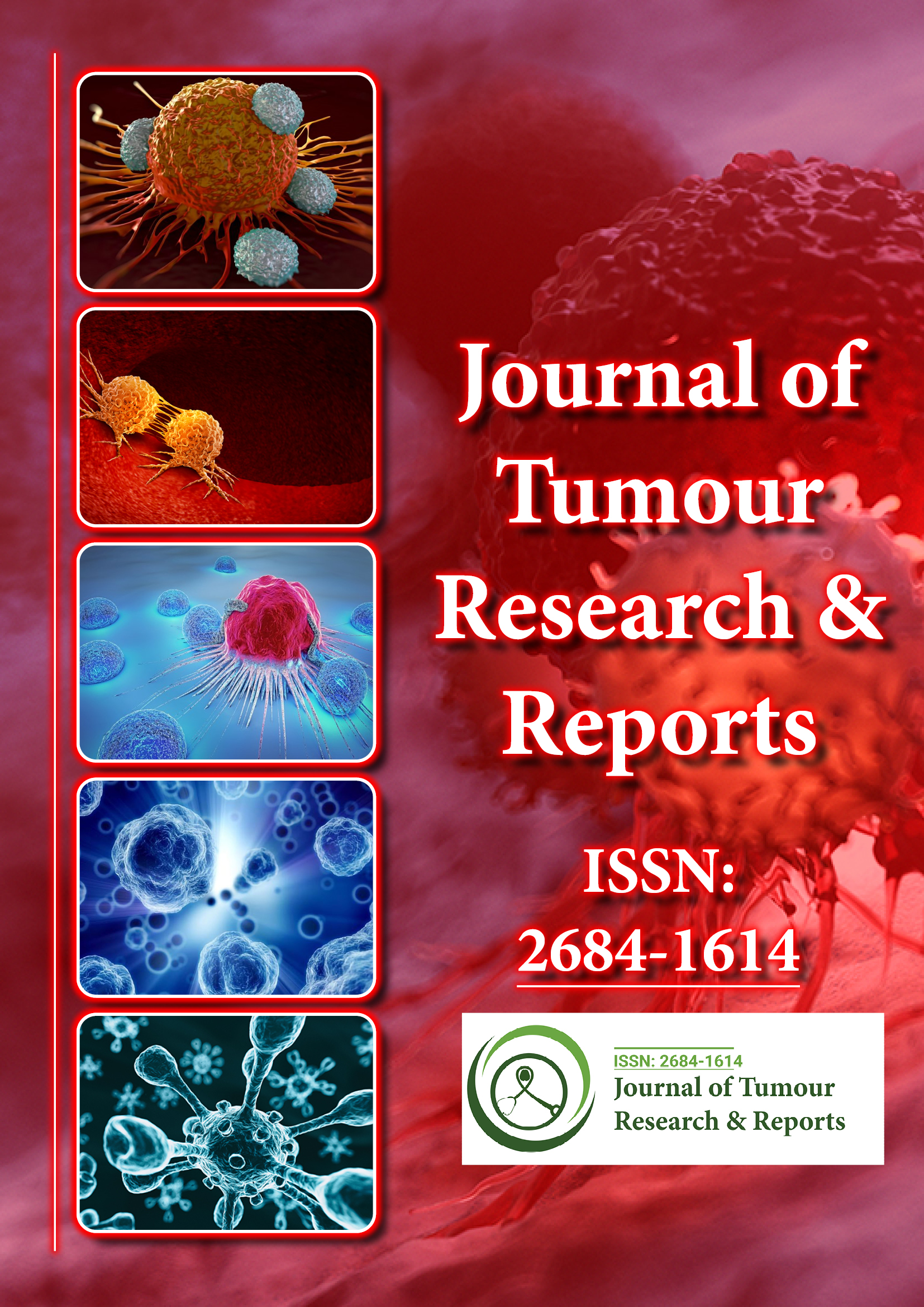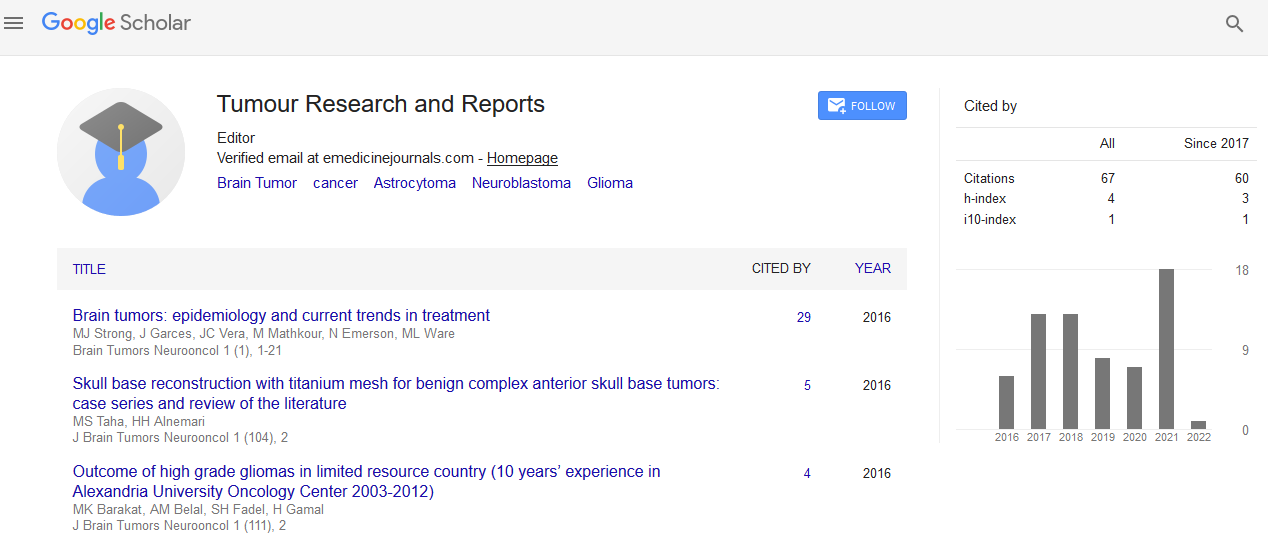Indexed In
- RefSeek
- Hamdard University
- EBSCO A-Z
- Google Scholar
Useful Links
Share This Page
Journal Flyer

Open Access Journals
- Agri and Aquaculture
- Biochemistry
- Bioinformatics & Systems Biology
- Business & Management
- Chemistry
- Clinical Sciences
- Engineering
- Food & Nutrition
- General Science
- Genetics & Molecular Biology
- Immunology & Microbiology
- Medical Sciences
- Neuroscience & Psychology
- Nursing & Health Care
- Pharmaceutical Sciences
Short Communication - (2023) Volume 8, Issue 2
Primary Chondroblastic Osteosarcoma of the Lung: Insights into Diagnosis, Treatment, and Prognosis
Rovirosa Ken*Received: 24-May-2023, Manuscript No. JTRR-23-22043; Editor assigned: 26-May-2023, Pre QC No. JTRR-23-22043 (PQ); Reviewed: 12-Jun-2023, QC No. JTRR-23-22043; Revised: 20-Jun-2023, Manuscript No. JTRR-23-22043 (R); Published: 28-Jun-2023, DOI: 10.35248/2684-1614.23.8.196
Description
Primary Chondroblastic Osteosarcoma (PCOS) is a rare form of cancer that originates in the bones. However, in extremely rare cases, it can also manifest in other tissues, including the lungs. Primary chondroblastic osteosarcoma of the lung is an extremely uncommon diagnosis, with only a handful of cases reported in medical literature [1]. Due to its rarity, this condition presents unique challenges in terms of diagnosis, treatment, and prognosis.
Understanding primary chondroblastic osteosarcoma
Osteosarcoma is a malignant bone tumour that primarily affects adolescents and young adults. It arises from the abnormal proliferation of osteoblasts, which are cells responsible for bone formation. Chondroblastic osteosarcoma is a subtype characterized by the presence of cartilage within the tumour [2]. Typically, primary osteosarcomas originate in the long bones, such as the femur, tibia, and humerus. However, in rare cases, they can develop in other locations, including the lungs.
Clinical presentation and diagnosis
The clinical presentation of primary chondroblastic osteosarcoma of the lung is nonspecific, often leading to delayed diagnosis. Patients may initially present with symptoms such as cough, chest pain, shortness of breath, or hemoptysis [3]. These symptoms can be mistaken for other more common respiratory conditions, such as pneumonia or bronchitis.
Diagnostic imaging plays a significant role in identifying and evaluating lung tumours. Chest X-rays, Computed Tomography (CT) scans, and Magnetic Resonance Imaging (MRI) can provide valuable information regarding the location, size, and characteristics of the tumour [4]. In the case of primary chondroblastic osteosarcoma of the lung, imaging studies may reveal a solitary mass or multiple nodules within the lung parenchyma.
However, a definitive diagnosis of primary chondroblastic osteosarcoma of the lung requires histological analysis. This is typically achieved through a biopsy of the tumour tissue [5]. During the biopsy, a small sample of the tumour is obtained and examined under a microscope by a pathologist. The presence of characteristic features, such as the presence of bone and cartilage, confirms the diagnosis of primary chondroblastic osteosarcoma [6].
Treatment approaches
Primary chondroblastic osteosarcoma of the lung is a challenging condition to manage due to its rarity and the lack of standardized treatment guidelines. The optimal treatment strategy often depends on various factors, including the extent of the disease, the presence of metastasis, and the overall health of the patient.
Surgery is the mainstay of treatment for localized tumours. In cases where the tumour is confined to the lung and has not spread to nearby lymph nodes or distant sites, a surgical resection of the tumour may be attempted [7]. The goal is to remove the tumour along with a margin of healthy tissue to minimize the risk of recurrence. However, due to the delicate nature of lung tissue, complete resection may not always be feasible.
Chemotherapy is frequently employed in the management of osteosarcoma, including primary chondroblastic osteosarcoma of the lung [8]. Adjuvant chemotherapy, given after surgery, helps to eradicate any remaining cancer cells and reduce the risk of recurrence. Chemotherapeutic agents commonly used in the treatment of osteosarcoma include cisplatin, doxorubicin, and methotrexate.
Radiation therapy may be considered in certain cases, either as a primary treatment option or in combination with surgery and chemotherapy [9]. The use of radiation therapy in primary chondroblastic osteosarcoma of the lung is still under investigation, and its efficacy in improving outcomes is yet to be determined.
Prognosis and follow-up
Primary chondroblastic osteosarcoma of the lung carries a relatively poor prognosis compared to its bone counterpart. The rarity of this condition makes it challenging to gather sufficient data on long-term outcomes.
Regular follow-up is essential for patients diagnosed with primary chondroblastic osteosarcoma of the lung. Close monitoring is necessary to detect any signs of recurrence or metastasis [10]. Follow-up visits typically include physical examinations, imaging studies, and laboratory tests. The frequency and duration of follow-up appointments may vary depending on the individual patient and the stage of the disease.
References
- Wang P, Zhu J, Long Q, Wang Y, Xu H, Tao H, et al. LncRNA SATB2-AS1 promotes tumour growth and metastasis and affects the tumour immune microenvironment in osteosarcoma by regulating SATB2. J. Bone Oncol. 2023:100491.
- Jin J, Cong J, Lei S, Zhang Q, Zhong X, Su Y, et al. Cracking the code: Deciphering the role of the tumour microenvironment in osteosarcoma metastasis. Int. Immunopharmacol. 2023;121:110422.
[Crossref] [Google Scholar] [PubMed]
- Hayes C, Douglass CW, Kim FM, Burgard SL, Couper D, Simon MA, et al. A case-control study of topical and supplemental fluoride use and osteosarcoma risk. J Am Dent Assoc. 2021;152(5):344-53.
[Crossref] [Google Scholar] [PubMed]
- Sarver AL, Mills LJ, Makielski KM, Temiz NA, Wang J, Spector LG, et al. Distinct mechanisms of PTEN inactivation in dogs and humans highlight convergent molecular events that drive cell division in the pathogenesis of osteosarcoma. Cancer Genet. 2023;276:1-1.
[Crossref] [Google Scholar] [PubMed]
- Cai X, Zhu S. Prognosis-related VDAC1 regulates the proliferation and apoptosis of osteosarcoma cells via the MAPK signaling pathway. Genomics. 2023;115(3):110595.
[Crossref] [Google Scholar] [PubMed]
- Xie L, Cai Z, Lu H, Meng F, Zhang X, Luo K, et al. Distinct genomic features between osteosarcomas firstly metastasing to bone and to lung. Heliyon. 2023;9(5).
[Crossref] [Google Scholar] [PubMed]
- Feng C, Jiang Y, Wang T, Tian D, Shen C, Wang Y, et al. Recent advances on nanostructured biomaterials in osteosarcoma treatment. Coord. Chem. Rev. 2023;493:215315.
- Ma X, Xu W, Jin X, Mu H, Wang Z, Hua Y, et al. Telocinobufagin inhibits osteosarcoma growth and metastasis by inhibiting the JAK2/STAT3 signaling pathway. Eur. J. Pharmacol 2023;942:175529.
[Crossref] [Google Scholar] [PubMed]
- Xiang D, Han X, Li J, Zhang J, Xiao H, Li T, et al. Combination of IDO inhibitors and platinum (IV) prodrugs reverses low immune responses to enhance cancer chemotherapy and immunotherapy for osteosarcoma. Mater. Today Bio. 2023;20:100675.
[Crossref] [Google Scholar] [PubMed]
- Jeremiasse B, Hulsker CC, van den Bosch CH, Buser MA, van der Ven CP, Bökkerink GM, et al. Fluorescence Guided Surgery using Indocyanine Green for Pulmonary Osteosarcoma Metastasectomy in Pediatric Patients A feasibility study. Eur. J. Cancer Pediatr. Oncol. 2023:100019.
Citation: Ken R (2023) Primary Chondroblastic Osteosarcoma of the Lung: Insights into Diagnosis, Treatment, and Prognosis. J Tum Res Reports. 8:187.
Copyright: © Ken R. This is an open access article distributed under the terms of the Creative Commons Attribution License, which permits unrestricted use, distribution, and reproduction in any medium, provided the original author and source are credited.

